Marcia Thornton Jones's Blog, page 145
October 11, 2016
Suspense, In Short
from Jody Feldman

Short. Quick. Heart. Breaths. Go. Forward. Stop! No! Yes!
No one really taught me the value of using words to mimic the beating of the heart and the panting of breaths in suspenseful situations. It was probably more like osmosis, absorbed through all those mysteries I read and all the quick-cut scenes I viewed in action-packed movies and TV. I’ve worked with that technique a lot. Sentences that start and stop and huff and puff and turn at the—
Wait! What? Who? Help!
And yet, with my latest published book, The Gollywhopper Games: Friend or Foe, I needed a little reminder. It took my editor suggesting that I could do the same with intercutting (in a literary way) chapters. I loved how it worked so much, I’m employing a similar version in my work-in-progress. What’s that book about? I don’t want to leave you in suspense so it’s about these kids and this huge...
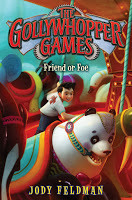 ...sorry. I am leaving you in suspense. But hopefully not for long.
...sorry. I am leaving you in suspense. But hopefully not for long.

Short. Quick. Heart. Breaths. Go. Forward. Stop! No! Yes!
No one really taught me the value of using words to mimic the beating of the heart and the panting of breaths in suspenseful situations. It was probably more like osmosis, absorbed through all those mysteries I read and all the quick-cut scenes I viewed in action-packed movies and TV. I’ve worked with that technique a lot. Sentences that start and stop and huff and puff and turn at the—
Wait! What? Who? Help!
And yet, with my latest published book, The Gollywhopper Games: Friend or Foe, I needed a little reminder. It took my editor suggesting that I could do the same with intercutting (in a literary way) chapters. I loved how it worked so much, I’m employing a similar version in my work-in-progress. What’s that book about? I don’t want to leave you in suspense so it’s about these kids and this huge...
 ...sorry. I am leaving you in suspense. But hopefully not for long.
...sorry. I am leaving you in suspense. But hopefully not for long.
Published on October 11, 2016 03:38
October 10, 2016
Suspense: Figments of Your (Character’s) ImaginationBy Ma...
Suspense: Figments of Your (Character’s) Imagination
By Marcia Thornton Jones
The summer of 1977 was the summer from hell, especially if you lived in Manhattan. The city was broke, a heat wave held everyone captive, and a serial killer was picking off young lovers in parked cars. Nora, the main character in Meg Medina’s novel BURN BABY BURN, lives everyday wondering if she might be the next victim in the cross hairs of the killer’s gun.
BURN BABY BURN is not a typical oh-my-gawd-we’re-going-to-die suspense novel, and it’s not about an axe-wielding masked killer bludgeoning his way through a slumber party with blood-in -your-face gore. Instead, Medinauses the character’s imagination based on primal fear to build suspense. Is the killer in the car parked across the street? Is he waiting in the shadows between work and home? Is he peeking in the windows?
I believe one of the best ways to learn about writing is to read books and ask what the author did to make the work successful. The lesson from Medina’s novel is that suspense is heightened using the characters’ imaginations and worries that prey on primal fears and insecurities.
Medina’s main character, Nora, sums this type of suspense up in her own words after the serial killer is caught:
“Is it crazy to be disappointed by a monster? He’s nothing like what we’ve imagined…I wonder if everything we fear is somehow the same as the unmasking of Son of Sam. Maybe the things that scare us seem more powerful than they truly are when we keep them secret.”
(BURN BABY BURN by Meg Medina, Candlewick Press, 2016, page 287)
By Marcia Thornton Jones
The summer of 1977 was the summer from hell, especially if you lived in Manhattan. The city was broke, a heat wave held everyone captive, and a serial killer was picking off young lovers in parked cars. Nora, the main character in Meg Medina’s novel BURN BABY BURN, lives everyday wondering if she might be the next victim in the cross hairs of the killer’s gun.
BURN BABY BURN is not a typical oh-my-gawd-we’re-going-to-die suspense novel, and it’s not about an axe-wielding masked killer bludgeoning his way through a slumber party with blood-in -your-face gore. Instead, Medinauses the character’s imagination based on primal fear to build suspense. Is the killer in the car parked across the street? Is he waiting in the shadows between work and home? Is he peeking in the windows?
I believe one of the best ways to learn about writing is to read books and ask what the author did to make the work successful. The lesson from Medina’s novel is that suspense is heightened using the characters’ imaginations and worries that prey on primal fears and insecurities.
Medina’s main character, Nora, sums this type of suspense up in her own words after the serial killer is caught:
“Is it crazy to be disappointed by a monster? He’s nothing like what we’ve imagined…I wonder if everything we fear is somehow the same as the unmasking of Son of Sam. Maybe the things that scare us seem more powerful than they truly are when we keep them secret.”
(BURN BABY BURN by Meg Medina, Candlewick Press, 2016, page 287)
Published on October 10, 2016 12:53
October 8, 2016
Cliff Hanging by Jane Kelley
We all want to write a page-turner. A book that's so engrossing the reader doesn't want to put it down. We want the reader to ignore the realities of her or his world to stay in the one WE made out of words and spaces. That's why many writers end each chapter with the hero hanging by her fingernails from the edge of a cliff.
Most cliffs are not actually cliffs. They are doors that slowly open. Or are locked. Telephones that ring. Or don't work. People who arrive in the middle of the night. Or who miss their trains. In other words, they are ordinary occurrences that writers must somehow make extraordinary.
How do we do that?
Atmospherics help. There's a reason it's often a "dark and stormy night."
Backstory can be useful. Every location is haunted by some sort of history.
I also remind myself that stories are about what's possible---not what's probable. I try not to let the structure of my story be locked up tight. I always leave space for something unexpected. If it surprises me, I know it will delight my readers.
Leave a door open--just a little bit. You never know what might come in.
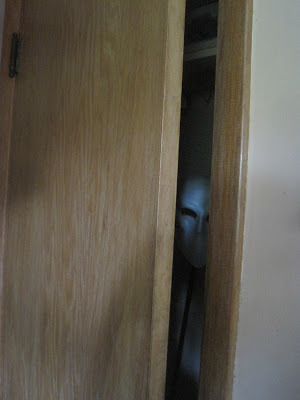
Most cliffs are not actually cliffs. They are doors that slowly open. Or are locked. Telephones that ring. Or don't work. People who arrive in the middle of the night. Or who miss their trains. In other words, they are ordinary occurrences that writers must somehow make extraordinary.
How do we do that?
Atmospherics help. There's a reason it's often a "dark and stormy night."
Backstory can be useful. Every location is haunted by some sort of history.
I also remind myself that stories are about what's possible---not what's probable. I try not to let the structure of my story be locked up tight. I always leave space for something unexpected. If it surprises me, I know it will delight my readers.
Leave a door open--just a little bit. You never know what might come in.

Published on October 08, 2016 02:30
October 5, 2016
Finding Your Suspense by Deborah Lytton -- October Theme
Growing up, I was a Nancy Drew fan girl through and through. I read and re-read the books just to experience that moment when I feared what might happen and yet had to read on anyway. I chewed many fingernails in those moments (to my mother's dismay) but I also learned one of the most important lessons in story crafting--suspense. Mildred Wirt Benson, who was the author of many of my favorite Nancy Drew mysteries (writing under the pen name of Carolyn Keene) layered suspense into every single page. The art of creating suspense isn't just reserved to mystery authors. We all need to balance sharing just enough to keep the reader connected but not so much that we give away our greatest reveals. It's that suspense which drives the plot forward and begs the reader to turn the page. Here are some of my suspense tools:
1. Begin at the end. I always know where I am going to finish (even if I have absolutely no idea how I will get there). Working backwards helps in layering the small clues for the reader. Clues make the story real, and ground the resolution in honesty.
2. Another thing that helps is being aware of the power of chapters. Some of the best writers break the chapter at the exact moment of suspense, rather than resolving the excitement before turning to a new chapter. This propels the reader forward organically.
3. Mixing points of view can add a great deal of suspense. Switching back and forth between characters allows for a break in the action from the plot surrounding one character while moving to the other character's story. In this way, the action never slows and the reader must continue to chase it.
For any Nancy Drew fan girls, share the title your favorite book in the series. Mine would be The Hidden Staircase.
Happy writing!
1. Begin at the end. I always know where I am going to finish (even if I have absolutely no idea how I will get there). Working backwards helps in layering the small clues for the reader. Clues make the story real, and ground the resolution in honesty.
2. Another thing that helps is being aware of the power of chapters. Some of the best writers break the chapter at the exact moment of suspense, rather than resolving the excitement before turning to a new chapter. This propels the reader forward organically.
3. Mixing points of view can add a great deal of suspense. Switching back and forth between characters allows for a break in the action from the plot surrounding one character while moving to the other character's story. In this way, the action never slows and the reader must continue to chase it.
For any Nancy Drew fan girls, share the title your favorite book in the series. Mine would be The Hidden Staircase.
Happy writing!
Published on October 05, 2016 22:26
October 3, 2016
Writing Craft: Suspense in Middle Grade Novels
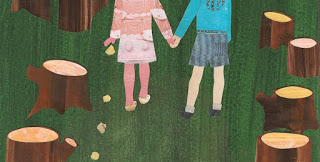 For a long time I didn't understand suspense - I thought that unless I was writing a mystery or thriller that it didn't really apply to my stories.
For a long time I didn't understand suspense - I thought that unless I was writing a mystery or thriller that it didn't really apply to my stories.Well. That might be why those early stories are stashed now in a dark drawer. ALL writing involves suspense. Or, at least it should. This is one of the many areas of writing where I am still learning.
Earlier this year I heard picture book author/illustrator Rowboat Watkins proclaim during his Ezra Jack Keats award speech that "picture books are the art of seduction."
Yes, even picture books involve suspense! The whole goal is to keep the reader turning the pages.
So how does one do this? Here are three ideas that resonate with me:
1. Make the reader promises. This is the part where you drop the breadcrumbs, doling out information little by little. Or using Rowboat's analogy, think of it as a strip tease: a bit more skin and then more and then more and more. I know this is where I have often failed -- giving too much information too soon. (An editor whose name I cannot recall at another conference said specifically when writing opening pages to err on the side of intrigue... information slows down the start of a book.) Often this oversharing is related to how we writers are discovering our stories as we go. So, in those early drafts we put everything we know right there on the page. During revision, we need to tease that out strategically and also eliminate anything that's unnecessary.
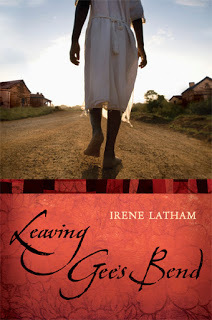 2. Make the reader worry. When I do school visits related to my historical middle grade novel LEAVING GEE'S BEND, many readers cite Ludelphia's time on the river as their favorite part of the book. Because Ludelphia was out of her comfort zone, on a storm-swollen river, all alone, and she couldn't swim. Would she get injured? Would she make it? If so, how? This is also the part where we be get to be the mean, evil writers and make our characters struggle through the worst thing that can possibly happen to them. It's hard! But essential for creating suspense.
2. Make the reader worry. When I do school visits related to my historical middle grade novel LEAVING GEE'S BEND, many readers cite Ludelphia's time on the river as their favorite part of the book. Because Ludelphia was out of her comfort zone, on a storm-swollen river, all alone, and she couldn't swim. Would she get injured? Would she make it? If so, how? This is also the part where we be get to be the mean, evil writers and make our characters struggle through the worst thing that can possibly happen to them. It's hard! But essential for creating suspense.3. Make the reader wait. Lee Child said in this New York Times piece, "So don't bake cakes. Make your family hungry instead." Hold out as long as you can to make the reader comfortable/satisfied. This doesn't mean nonstop action. This means breaks between the action. This is where you cut to another scene/character. This is where someone comes in and interrupts a conversation just when the pivotal question has been posed. It's this kind of attention that creates the biggest emotional payoff.
So: go forth and make your readers hungry!
---------------------------------
Irene Latham is the award winning author of two novels for children LEAVING GEE'S BEND and DON'T FEED THE BOY. Named the winner of the 2016 International Literary Association-Lee Bennett Hopkins Promising Poet Award, her current focus is on poetry for children. Titles include DEAR WANDERING WILDEBEEST, which was named an SCBWI Lee Bennett Hopkins Poetry Award Honor book, FRESH DELICIOUS:Poems from the Farmers' Market, and WHEN THE SUN SHINES ON ANTARCTICA. irenelatham.com
Published on October 03, 2016 03:30
October 2, 2016
What Was That Noise? By Ann Haywood Leal
 My mom couldn't stand the suspense of an unopened gift or an unknown resolution in a novel. She'd try very hard to resist the impulse, but she'd almost always give in and read the end of that book.
My mom couldn't stand the suspense of an unopened gift or an unknown resolution in a novel. She'd try very hard to resist the impulse, but she'd almost always give in and read the end of that book.My aunt made the most delicious fudge from a secret recipe that she refused to divulge, and she'd only make it at Christmas. My mom knew that fudge was arriving at our house around December 20, or so, and she adored and craved that fudge like the rest of us. We were all shocked one year when the box still lay unopened under the tree on December 25 . . . until my brother opened it and found an entire corner of fudge cut out and missing.
Annie Dillard once said, "Do not hoard what seems good for a later place in the book, or for another book; give it, give it all, give it now." It's one of my favorite writing quotes. My mom would have loved that quote, but I'm quite sure Ms. Dillard wasn't referring to suspense.

Suspense has to be stretched out until the rubber band is just about to snap.
What's inside the box?
What's behind the door?
What's around the corner?
Didn't you hear that?
You wake up in the darkness of your room . . . Did you just dream that voice? . . . Or did it come from downstairs?
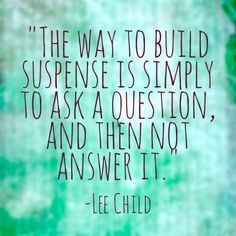
We have to give it away a trickle at a time, but do give a glimpse to keep the reader wondering and turning those pages. Give a quick flash of what is around that corner. Make them want to sneak into that box of fudge.
I leave you with another quote and a challenge from the incomparable Stephen King:
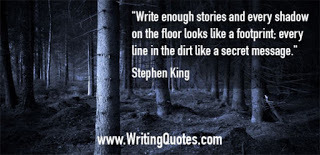
Published on October 02, 2016 05:49
September 25, 2016
THINGS I ADMIRE ABOUT MY CHARACTERS - HOLLY SCHINDLER
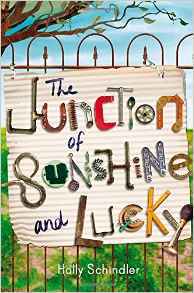
My favorite thing about Auggie, the star of THE JUNCTION OF SUNSHINE AND LUCKY, is her positive outlook--and the way she never sees things as they are but as they can be. Auggie looks at a rusted pipe and thinks, "Flower." Or, "Wind chime." Or, "A woman dancing." If she didn't have that kind of outlook, she'd never become a folk artist.
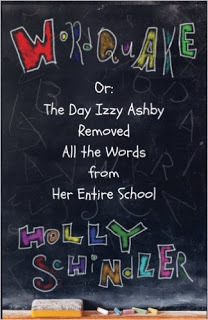
My favorite thing about Izzy, the main character of WORDQUAKE, is that she'd open-minded. As the story opens, she considers books to be nothing more than dusty, mind-numbing old weekend-stealers written by dead guys who'd probably bored themselves to death.
The adventure she embarks on shows her a new way to look at the written word, though. And Izzy lets it. I mean, a character can go on the world's most amazing journey--but if he or she is close-minded, they'll miss out on seeing the world from a new angle. They'll miss out on letting that adventure have an impact on them. Not Izzy, though. She lets the events of a single day change her...now, that you just can't help but admire.
Published on September 25, 2016 05:00
September 22, 2016
What’s Missing? Story Structure! Smack-Dab-in-the-Classroom by Dia Calhoun
From the private Creative Writing mentoring I do for both adults and kids, I’ve discovered many people have a poor understanding of story structure. It isn’t really taught in general creative writing classes, beyond perhaps pointing out that a story needs a beginning, middle, and end.
Perhaps this lack isn’t surprising, if you consider all the many and often complex techniques of looking at story structure. You can read STORY, by Robert McKee, for a super in depth version. But the simplest, quickest technique I’ve found is in Eve Heidi Bine-Stock’s book, How to Write a Children’s Picture Book, Vol. 1: Structure. She developed her story structure chart for picture books, but I’ve found it very useful to give me a quick snapshot of novel structure. And an easy way to try many ideas out quickly.
Bine-Stock explains the chart using well known picture books as examples, so this book would be a useful and accessible way for a middle school or secondary school teachers to teach story structure. Have the kids look at a few middle grade novels using the chart as well. Whether teaching literature or creative writing, this book would be a great tool for teaching story structure.
Perhaps this lack isn’t surprising, if you consider all the many and often complex techniques of looking at story structure. You can read STORY, by Robert McKee, for a super in depth version. But the simplest, quickest technique I’ve found is in Eve Heidi Bine-Stock’s book, How to Write a Children’s Picture Book, Vol. 1: Structure. She developed her story structure chart for picture books, but I’ve found it very useful to give me a quick snapshot of novel structure. And an easy way to try many ideas out quickly.
Bine-Stock explains the chart using well known picture books as examples, so this book would be a useful and accessible way for a middle school or secondary school teachers to teach story structure. Have the kids look at a few middle grade novels using the chart as well. Whether teaching literature or creative writing, this book would be a great tool for teaching story structure.
Published on September 22, 2016 22:00
Finding our Characters' Broken Places by Laurie Calkhoven
I’ve enjoyed everyone’s thoughts this month on our characters’ dark sides—how we find them and how we write about them. The fact is that we all have dark sides. We hope that the good is the side that mostly presents itself to the world, but we all have them.
 When I’m getting to know my characters, letting them tell me who they are and what they want, I always ask them to tell me about their broken places. They can be as simple as being the shortest kid in the class (like Claudia’s character) or as complex and overwhelming as learning your father just isn’t interested in you (like Michael does in Michael at the Invasion of France). But it’s those broken places that explain the darkness in our characters and give us a path to lead them to the light.
When I’m getting to know my characters, letting them tell me who they are and what they want, I always ask them to tell me about their broken places. They can be as simple as being the shortest kid in the class (like Claudia’s character) or as complex and overwhelming as learning your father just isn’t interested in you (like Michael does in Michael at the Invasion of France). But it’s those broken places that explain the darkness in our characters and give us a path to lead them to the light.
 When I’m getting to know my characters, letting them tell me who they are and what they want, I always ask them to tell me about their broken places. They can be as simple as being the shortest kid in the class (like Claudia’s character) or as complex and overwhelming as learning your father just isn’t interested in you (like Michael does in Michael at the Invasion of France). But it’s those broken places that explain the darkness in our characters and give us a path to lead them to the light.
When I’m getting to know my characters, letting them tell me who they are and what they want, I always ask them to tell me about their broken places. They can be as simple as being the shortest kid in the class (like Claudia’s character) or as complex and overwhelming as learning your father just isn’t interested in you (like Michael does in Michael at the Invasion of France). But it’s those broken places that explain the darkness in our characters and give us a path to lead them to the light.
Published on September 22, 2016 03:00
September 20, 2016
INTERVIEW WITH TRUTH OR DARE AUTHOR BARBARA DEE
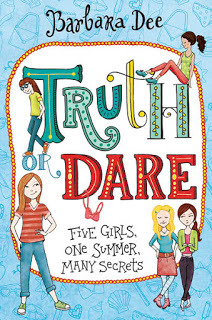 I love the concept of TRUTH OR DARE—and the title! Your book is so spot-on for this age group. How did you tap into that middle grade mindset?
I love the concept of TRUTH OR DARE—and the title! Your book is so spot-on for this age group. How did you tap into that middle grade mindset? I often wonder the same thing! Seriously, it's just my default mindset when I'm writing. Either I'm an angsty twelve year old or Adult Me. The latter when I'm conducting business, the former when I'm creating fiction!
Beyond the exploration of the awful spiraling effects of lying, you really dig into the ins and outs of young girlhood friendships (I especially love the description of the ways in which Lia’s friends can so quickly seem to move on without her while she’s on vacation.) How much of your own childhood friendships seep into your work? Or, conversely, do you find yourself inspired to write about things that happen to your own children?
I never directly, consciously poach anything from my kids or from my own past. But as we know, stuff seeps in. Sometimes you don't realize it until you read back what's on the page.
When did you start writing? Do you remember your first attempt at story-telling? What inspired you then? What inspires you now?
I've always written. When I was five, I wrote my first "book"--"Mitchell Colleps"--about a mischievous boy with a robot who ate Spanish rice. My mom sewed the binding in pink wool, and I still have it. There's a photo of it on my website, www.BarbaraDeeBooks.com, and sometimes I bring it with me to school visits, to show kids that dreams can come true. "Mitchell Colleps" was inspired by an imaginary friend of mine. I can't say I still have imaginary friends--but often, when I've finished writing a book, the characters have become so real to me it's hard to let them go.
Your website bio indicates that your favorite word is “definitely.” Love that! (Anyone who writes can sometimes struggle to maintain a positive outlook.) How do you maintain it? (PS: I say definitely cats—my first-ever friend was a yellow one. And I also say definitely dogs—my current pet is a very spoiled Peke.)
I think that if you love writing, it's *definitely* a privilege to be able to say that it's your career. Some days it's hard--okay, impossible-- not to feel demoralized. Authors are no strangers to rejection and indifference. HOWEVER, we get to play with our naughty cats (like my Luna and Coal) and our sweet dogs (like my lovely hound, Ripley) while we tell ourselves stories. In our fuzzy slippers!! How can we not be ecstatic about that?
I love the sweet, upbeat tone of TRUTH OR DARE. Do you have to work to find it? Did it come naturally? Do you have any tips for finding a character’s voice?
I have to say the voice comes naturally to me. I think it you have to work too hard to find it, and to maintain it, it's probably going to seem forced and unnatural on the page. Here's what I tell writers who are developing their voice: If you're writing for kids, try to hang out with kids, and eavesdrop on speech patterns. Then, when you've written something in a kid's voice, read it out loud. Listen for things like contractions: if you aren't using them, your voice is probably too formal and adult.
I also love the discussion of “better or worse” in the book (Lia’s optometrist dad is always asking “better or worse,” while Aunt Shelby thinks dividing experiences this way is a waste of time. Where’d that idea come from?
I have terrible eyes, so they're always getting checked. I guess that phrase just hit me one day. One of the themes I keep coming back to in my books is realizing that people aren't either/or, black/white. We're all just grey, really--rounded, imperfect, inconsistent. So having a job that makes you see the world in either/or ways all day long is kind of horrifying to me.
Perhaps my favorite part of the book is the idea that losing friends lets you gain superpowers (invisibility and super vision). Lia’s actually dealt with a lot of loss: her mother has died as well. Do you think children deal with loss differently than adults? How so?
Great question. I can tell you that I experienced great personal loss as a kid--and when it happened, I remember telling myself, "If I can get through this, I can get through anything." Do other kids feel this way when tragedy occurs? I hope so, because it really did help me. And I'm guessing that many adults don't feel this way in the face of a terrible loss, because they're not looking to the future as optimistically as kids are. Am I saying that kids are stronger and more resilient than adults? Sounds as if I am.
Which is tougher—writing or teaching? More rewarding?
Hoo boy, tough one. There's nothing more exhilarating than teaching when you've got a great bunch of kids, and you're all reading and discussing a book you truly love. But sometimes you don't get to choose the text. (At my former school, we had to teach tenth graders Alexander Pope's long poem, "The Rape of the Lock." Can you imagine?) At least when you're having a hard day as a writer, it's private. Teaching is a public performance requiring an endless supply of positive energy. So on balance...yep, teaching is harder. Definitely (Ooh, there's that word again!).
What’s your writing style? Plotter? Pantser? As writers, we’re always learning new tricks—what’s the biggest lesson you’ve learned about your own work in the last year?
Glad you asked this. I used to be a pantser, convinced that if I outlined, I'd lose the sense of adventure that made writing fun. Then three years ago, my oldest kid became very ill. For a year, I didn't write a word, spending my days with him at the hospital. (He's okay now, knock wood.) At the end of that year, I wanted to get back to work, but after so much time away from my desk, I didn't want to waste more time writing something that might not get published. So I forced myself to develop a detailed synopsis , which my agent and editor liked, and which became TRUTH OR DARE. I've written my next two books , STAR-CROSSED and STUFF I KNOW ABOUT YOU, synopsis first, and now I'm a total convert to this way of working. For me, the hardest part of writing is developing the plot, so if I get that out of the way first, the writing is a (relative!) breeze.
Can you tell us more about future releases? Works in progress? What’s next?
I'm especially excited about STAR-CROSSED (Aladdin/S&S--March 2017), which is about an eighth grade girl who realizes she has a crush on the girl playing Juliet in the eighth grade production of Romeo & Juliet. I guess my inner English teacher was behind this project, because I do use a lot of Shakespeare's play. I have to say that writing STAR-CROSSED was the most fun I've ever had writing a book--truthfully, it was a daily joy, and I'm happy to say that my book is not--I repeat , not-- a tragedy. I've also just not finished the first draft of STUFF I KNOW ABOUT YOU (Aladdin/S&S September 2017), which is about a free-spirited girl who discovers, over the course of a three-day school field trip to DC, that her roommate has an eating disorder. As a former anorexic myself, I've been horrified to read that eating disorders are showing up in tweens much more frequently these days, so I wanted to write a book that's actually enjoyable and funny--about a serious subject I'm passionate about.
Keep up with Barbara Dee: barbardeebooks.com!
Published on September 20, 2016 05:00



